An ADA Guide for Local Governments: Making Community Emergency Preparedness and Response Programs Accessible to People with Disabilities
SHELTERING
When disasters occur, people are often provided safe refuge in temporary shelters. Some may be located in schools, office buildings, tents, or other areas. Historically, great attention has been paid to ensuring that those shelters are well stocked with basic necessities such as food, water, and blankets. But many of these shelters have not been accessible to people with disabilities. Individuals using a wheelchair or scooter have often been able somehow to get to the shelter, only to find no accessible entrance, accessible toilet, or accessible shelter area.
Action Steps: Accessible Shelters
Survey your community’s shelters for barriers to access for persons with disabilities. For instance, if you are considering incorporating a particular high school gymnasium into your sheltering plan, early in the process you should examine its parking, the path to the gymnasium, and the toilets serving the gymnasium to make sure they are accessible to people with disabilities. If you find barriers to access, work with the facility’s owner to try to get the barriers removed. If you are unable to do so, consider another nearby facility for your community sheltering needs.
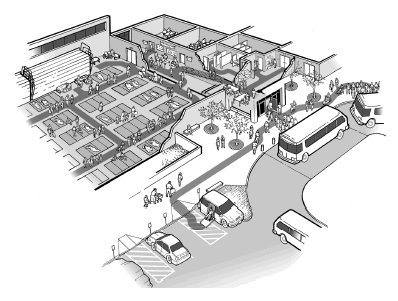
A shelter with accessible features including parking, drop-off area, entrance, toilet rooms, and sleeping areas.
Until all of your emergency shelters have accessible parking, exterior routes, entrances, interior routes to the shelter area, and toilet rooms serving the shelter area; you should identify and widely publicize to the public, including persons with disabilities and the organizations that serve them, the locations of the most accessible emergency shelters.
Shelter staff and volunteers are often trained in first aid or other areas critical to the delivery of emergency services, but many have little, if any, familiarity with the needs of people with disabilities. In some instances, people with disabilities have been turned away from shelters because of volunteers’ lack of confidence regarding the shelter’s ability to meet their needs. Generally, people with disabilities may not be segregated or told to go to “special” shelters designated for their use. They should ordinarily be allowed to attend the same shelters as their neighbors and coworkers.
Action Steps: Input on Shelter Planning and Staff Training
Invite representatives of group homes and other people with disabilities to meet with you as part of your routine shelter planning. Discuss with them which shelters they would be more likely to use in the event of an emergency and what, if any, disability-related concerns they may have while sheltering. Develop site-specific instructions for your volunteers and staff to address these concerns.
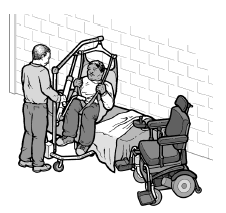
A shelter worker helps a person onto a cot using a portable lift provided by the shelter.
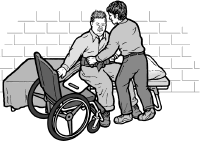
A shelter worker helps a man transfer onto a cot.
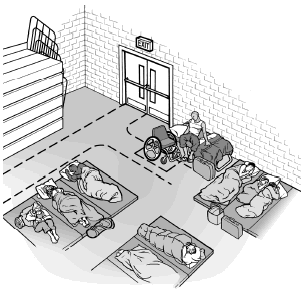
A individual who uses a wheelchair sits on a cot that is placed against a wall. The height of the bed and the wheelchair seat are of similar height making it possible for this person to transfer from the wheelchair to the bed.
Action Steps: Service Animals
Adopt procedures to ensure that people with disabilities who use service animals are not separated from their service animals when sheltering during an emergency, even if pets are normally prohibited in shelters. While you cannot unnecessarily segregate persons who use service animals from others, you may consider the potential presence of persons who, for safety or health reasons, should not be with certain types of animals.
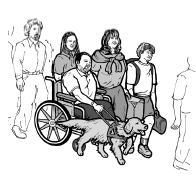
A man using a wheelchair arrives at a shelter with his family and service animal.
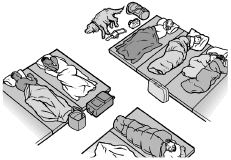
A woman has a service animal lying on the floor next to her cot.
Individuals whose disabilities require medications, such as certain types of insulin that require constant refrigeration, may find that many shelters do not provide refrigerators or ice-packed coolers. Individuals who use life support systems and other devices rely on electricity to function and stay alive and, in many cases, may not have access to a generator or other source of electricity within a shelter.
Action Steps: Medications, Refrigeration, and Back-up Power
Ensure that a reasonable number of emergency shelters have back-up generators and a way to keep medications refrigerated (such as a refrigerator or a cooler with ice). These shelters should be made available on a priority basis to people whose disabilities require access to electricity and refrigeration, for example, for using life-sustaining medical devices, providing power to motorized wheelchairs, and preserving certain medications, such as insulin, that require refrigeration. The public should be routinely notified about the location of these shelters. In addition, if you choose to maintain a confidential registry of individuals needing transportation assistance, this registry could also record those who would be in need of particular medications. This will facilitate your planning priorities.
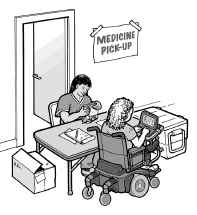
A person using a wheelchair picks up medication at the shelter.
People who are deaf or hard of hearing may not have access to audible information routinely made available to people in the temporary shelters. Individuals who are blind or who have low vision will not be able to use printed notices, advisories, or other written information.
Action Steps: Communications
Adopt procedures to provide accessible communication for people who are deaf or hard of hearing and for people with severe speech disabilities. Train staff on the basic procedures for providing accessible communication, including exchanging notes or posting written announcements to go with spoken announcements. Train staff to read printed information, upon request, to persons who are blind or who have low vision.
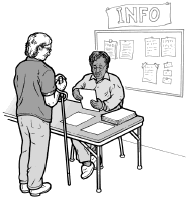
A shelter worker reads printed information to a woman who is blind.

User Comments/Questions
Add Comment/Question